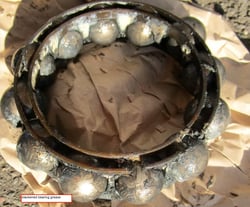Apr . 28, 2024 12:25 Back to list
Diagnosing Electrical Bearing Damage
When an electric motor bearing fails prematurely, you should try to determine why it failed. If you don't, you run the risk of repeated failure. And if one unexpected failure is bad, one after another is a lot worse.
There are any number of guides to bearing failure analysis out there. Many bearing manufacturers publish their own guides. In this article, we're only going to talk about electrical bearing damage, most often due to VFD control without proper protection. There are three main signs of electrical bearing damage: Burnt or blackened grease; frosting of the bearings and raceways; and fluting of the raceways.
When you cut a bearing for inspection, damage to the grease is the first thing you'll see. In the first photograph, you'll see that there are spots of creamy beige grease near the top. This is what the grease looked like when it was new. Contrast that with the grey/brown stained grease on the balls. That discoloration is a sign of electrical damage. When electrical arcing occurs in the bearing, it chemically damages the grease and causes discoloration. This damage decreases the grease's lubricating properties, which causes excess heating and hastens further damage.
This arcing also causes electric discharge machining (EDM). Each arc, like a tiny lightning bolt, blasts bits of metal off of the races and rolling elements. These bits of metal disperse into the grease, causing further discoloration.
The EDM process also leaves behind microscopic pits in the surface. These pits are tiny - on the order of one micron (about 1/25 000 of an inch). But in mass, they are visible as frosting. In the second and third photos, you can see bands of dull, matte surface along with the shinier undamaged metal. That matte surface is frosting. It is very common to see bands of frosting like this, while the rest of the raceway remains smooth and shiny.
In severe cases, frosting leads in turn to fluting. Fluting is a pattern of washboard like ridges along the bearing race. The beginnings of fluting are can be seen in the second photo (taken from the same machine as photo #1), and a more advanced case is shown below. Oftentimes, the flutes are concentrated in the load zone of the bearing. In the early stages of fluting, they are often more spread out. But over time, additional flutes develop between them. Fluting causes excessive vibration, noise, and heat generation. By the time a bearing is fluted, failure is near.

If a motor develops electrical bearing damage once, the chances are excellent that it will happen again, unless preventive measures are taken. In small, well-grounded motors, an AEGIS® Shaft Grounding Ring will do the trick. In motors over 100 hp (75 kW), we recommend an insulated bearing at the other end from the grounding ring, to interrupt high frequency circulating current. And in poorly grounded motors, we recommend that you bond the motor frame to its coupled equipment with a high frequency grounding strap, or use higher quality VFD cable.
AEGIS Rings also come with a 2-year extended warranty against bearing fluting damage. No other form of protection against VFD-caused bearing damage offers a warranty like this.
To learn more about AEGIS shaft grounding and best practices for electrical bearing protection, sign up for a training. We offer monthly live training webinars, and – pandemic restrictions permitting – we can also visit your facility to review your exact application.
Sign Up For Training
Latest news
-
Spherical Bearings Enabling Bionic Joint Over-Rotation
NewsAug.22,2025
-
Stainless Steel Sphericals: Botong's Harsh-Environment Heroes
NewsAug.22,2025
-
Spherical Roller Thrust Bearings For Space Elevator Anchors
NewsAug.22,2025
-
Axial Spherical Roller Bearing: Xingtai's Motion Architects
NewsAug.22,2025
-
Ceramic Coated Bearings For Fusion Reactor Plasma Whirlpools
NewsAug.22,2025
-
Botong's Zirconia Bearing: Defying Metal Limits
NewsAug.22,2025